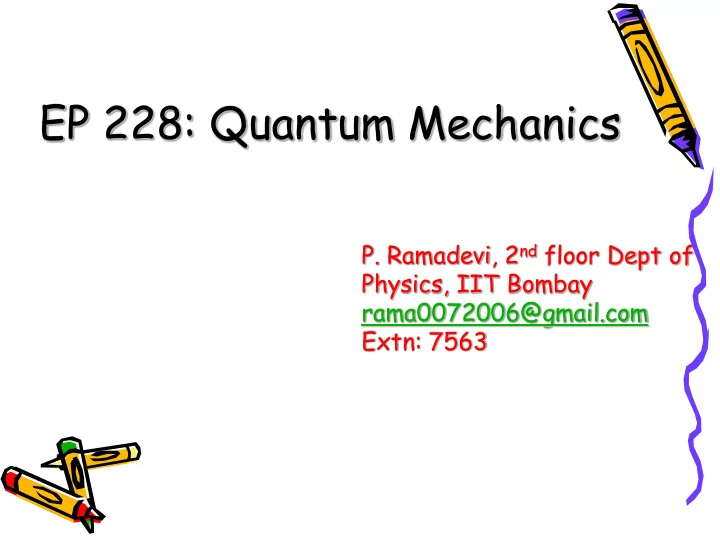

EP 228: Quantum Mechanics P. Ramadevi, 2 nd floor Dept of Physics, IIT Bombay rama0072006@gmail.com Extn: 7563
References • Griffiths-Introduction to Quantum Mechanics • Sakurai – Modern Quantum Mechanics • Shankar-Principles of Quantum Mechanics
In-Sem, End-sem • Two 10 marks quiz (one in first week of Feb and other in the last week of March) • Mid-Sem 30 marks • End-Semester 40 marks • Assignment 10 marks
Before Mid-Sem • Review quantum ideas (Wavefunction formalism) • Linear vector spaces • Operator, state vecor formalism of Harmonic oscillator
After Mid-Sem • Hydrogen atom, Angular Momentum • Spin • Addition of angular momentum • Clebesh-Gordan coefficients
Limitations of Classical ideas- need for Quantum theory • Experimental data in the Microscopic World (inside an atom or nucleus) – classical laws are inadequate 1) Black-Body Spectrum 2) Photo-electric effect 3) Compton scattering Needed introduction of a fundamental constant h (Planckconstant ) leading to the `Quantum’ regime Photons obey E= h ν and using relativistic energy for massless particles imply momentum of photon p=h/ λ Daring proposal of de-Broglie: equation for the wavelength of matter waves must obey the same equation of photon momentum
Matter waves • For an electron moving in a circular orbit of radius r, constructive interference of the electron wave with itself in the orbit requires 2 π R = n λ • Substituting de-Broglie proposal gives Bohr quantization mvr= n h/2 π • Electron diffraction expts : Davisson-Germer (confirms wave nature of electron)
Interference expt plot C for electron beam is observed (wave info) Attempting which slit the electron came from gives plot B(particle info) Either particle or wave nature can be observed The plot is actually probability curve for electron
Wave-particle duality • Classical Mechanics • Quantum Mechanics • both x, p can be • x,p cannot be simultaneously simultaneously determined precisely- found Heisenberg’s uncertainty principle • Equation is Schrodinger eqn • Equation is which determines probability Newton’s law amplitude Ψ (x,t) (complex) whose determines x,p modulus squared gives probability
Flow chart Particle Wave-nature nature of of particles (de-Broglie wave) light Photo-electric Blackbody Uncertainty Diffraction Effect Compton effect Wavepacket, radiation principle experiment Schrodinger Eqn Quantum Mechanics Matter wave probability Average We will see in detail
Wave-function < ∞ (for square Integrable)
Square-Integrable functions • Square integrable wavefunction Ψ (x,t) must go to zero faster than 1/√|x| as |x| - > +∞ • We can normalize such functions giving normalised wavefunction obeying
Normalisation constant Where N is finite Normalised wavefunction The normalisable wavefunctions satisfy Using time-dependent Schrodinger equation, show that Exercise 1
More Exercises 2) Starting from expectation value of x, show Exercise 3 Ehrenfest Theorem- expectation values obey classical laws
Discontinuous potentials V(x) Step function at x=0 For finite potentials, show that
For infinite potential Derivative of wavefunction is not continuous at x=0
Recommend
More recommend